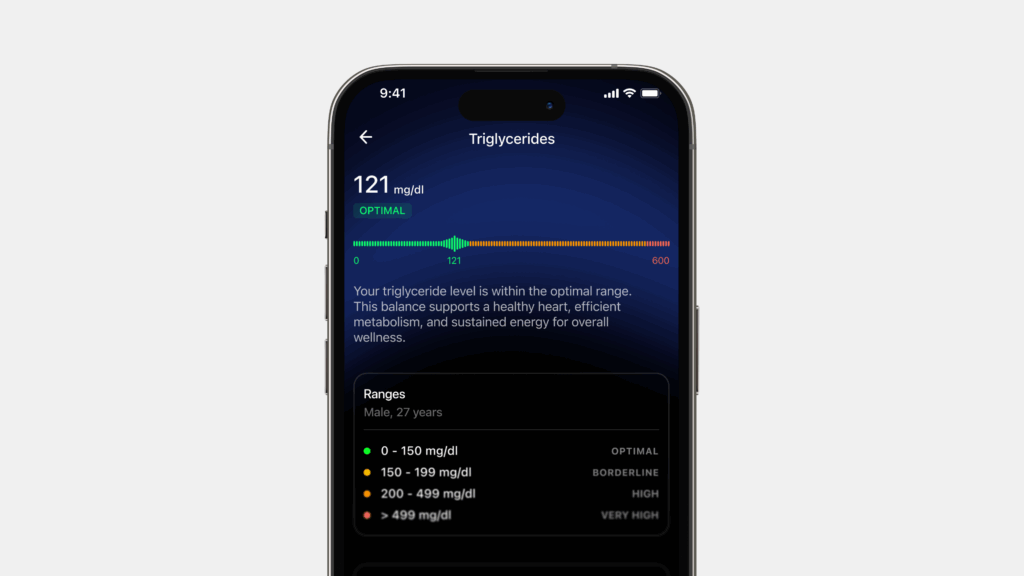What is metabolism?
Metabolism is a series of life-sustaining chemical processes in each cell transforming the calories we eat into fuel to keep us alive.
Simply put, metabolism takes place when the calories for dietary consumption combine with oxygen to release energy. (9) In addition, it extracts complementary elements, called endogenous metabolites to use these nutrients as energy effectively. For example, metabolism turns dietary fibre into short chain fatty acids (SCFAs), an essential component for liver function. (8)
(Read more about the basics of metabolism on our blog.)
Metabolic health can be described as having ideal levels of blood sugar, triglycerides, high-density lipoprotein (HDL) cholesterol, blood pressure, and waist circumference, without using medications.
What is inflammation?
Inflammation is a biological response to the body’s discovery of a foreign intruder. It combats the harmful elements present in our body, whether dietary or metabolic toxins, infections in our bloodstream, injuries on the skin surface or psychological stressors. This natural process is consistently responsible for helping the body heal. Without it, wounds and infections would be likely to cause us more harm as the body would be without its natural defense. (10)
Sometimes, the body erroneously perceives its own cells or tissues as dangerous. This reaction can lead to autoimmune diseases and other chronic conditions. A key feature of most metabolic disorders is inflammation.
Metaflammation refers to constant, low levels of inflammation throughout the body. This is a sub-optimal health condition that is considered a factor in chronic metabolism disorders.
What happens during inflammation?
There are 2 kinds of inflammation, namely acute and chronic. Acute inflammation is concentrated in a physical location and is typically short-term. When it takes place, there’s a dilation in blood vessels and an increase in blood flow. In order for healing to happen, there is a rush of white blood cells to the wounded and subsequently inflamed area. (10)
Chronic inflammation, on the other hand, can impact larger parts or all of our body for longer periods of time. When labelled as persistent from a low-level of inflammation caused over more drawn out periods of time, chronic inflammation raises immune system measures found in one’s blood or tissue.(11)
A chronic inflammatory response can eventually start damaging healthy cells, tissues, and organs. Over time, it is conducive to DNA damage, tissue death, and internal scarring.
Oxidative stress is defined as a disturbance in the balance between the production of reactive oxygen species (free radicals) and antioxidant defences. Free radicals fight pathogens that provoke infections. They are extremely reactive, while antioxidants stabilize the reactive nature of free radicals, creating harmony. A reactive oxygen species (ROS) is a molecule containing oxygen that has gained an extra electron. This causes the molecule to become highly chemically reactive. These free radicals are produced during normal cell metabolism. ROS accumulation leads to dysfunction in the neurons.
Oxidative stress can lead to chronic inflammation. Infections and injuries activate the body’s immune response. Immune cells known as macrophages generate free radicals while combating invading germs. These free radicals can be detrimental to healthy cells, causing inflammation. It usually goes away after the immune system overthrows the infection or repairs the damaged tissue.
But oxidative stress can also stimulate the inflammatory response, which consequently produces more free radicals leading to additional oxidative stress and perpetuating a cycle. Chronic inflammation due to oxidative stress may lead to several conditions, including diabetes, cardiovascular disease.
How are metabolism and inflammation connected? (7)
There are significant ties between metabolism and inflammation. This is detailed in a 2021 review of studies on the subject by Roche. (6) Essentially, lifestyle choices like our diet, the amount of exercise we undertake, how much alcohol we consume, and smoking become factors that affect cellular metabolism. In turn, this influences our inflammatory response when it occurs. This can either be towards inflammation staying present or towards the process of inflammation fulfilling its resolutory function. In the former, a cycle of increased glycolysis (a series of reactions that help extract energy from glucose) and inflammation increases mitochondrial stress ( principal regulators of cellular function and metabolism through the production of ATP for energy homeostasis. ). In the latter cycle, fatty acid oxidation reduces inflammation and increases immune surveillance correspondingly causing a drop in oxidative stress or ROS levels, ie, elevated levels or reactive oxygen that can damage DNA, lipids, and proteins. (12)
One of the factors leading to insulin resistance is low-grade inflammation or metabolic inflammation. Insulin resistance (when cells in your muscles, fat, and liver don’t respond well to insulin and can’t easily take up glucose from your blood) forces β-cells to produce more insulin in order to cope with body demands and to maintain glucose homeostasis. When the pancreas is no longer able to facilitate appropriate insulin secretion, hyperglycemia (high blood sugar) is detected. Research confirms that one of the mechanisms leading to insulin resistance is low-grade inflammation that ropes in a host of protagonists such as inflammatory cytokines (small proteins important in cell signalling), lipids and their metabolites, reactive oxygen species (ROS), hypoxia (a condition in which the body or a region of the body is deprived of adequate oxygen supply at the tissue level) and changes in gut microbiota profiles.
Further, there is the case of metabolic inflammation, aka metaflammation. This is found in people with diets consisting of high levels of fat and sugars along with a sedentary lifestyle. (7) Metaflammation carries an association with type 2 diabetes (13) as well as non-alcoholic fatty liver disease. (14)
Metabolic inflammation is a state of diluted chronic inflammation induced in the body during obesity. When obese, the body may release hypertrophied adipocytes (a tissue with nutrient buffering capacity as a response to nutritional excess) and inflammatory cells of pro-inflammatory cytokines (small proteins released by cells with particular impact on inter-cell communication and interactions) (18). With an increase in fatty acid, these cytokines signal pathways to inhibit insulin receptors. Further, this pathway can activate NFkB (a protein complex that controls transcription of DNA, cytokine production and cell survival)- resulting in chronic inflammation from a release of further inflammatory cytokines. The components in one’s gut fluids may also play a meaningful part in insulin resistance based on signals from our gut’s epithelial cells. Further, stress in the endoplasmic reticulum can contribute to a spike in insulin resistance, while hydrophilic statins have a positive impact on insulin sensitivity. (17)

What is metabolic syndrome?
Metabolic syndrome is a cluster of conditions that simultaneously occur, increasing your risk of heart disease, stroke and type 2 diabetes. These conditions include increased blood pressure, high blood sugar, excess body fat around the waist, and abnormal cholesterol or triglyceride levels.
How can metabolic inflammation impact metabolic health? (2) (3)
How can metabolic inflammation impact mThe effects of obesity, a marker of metabolic impairment, on inflammation are an increase in storage of immune cells and a sharp polarity between its types. (2) This polarity of inflammatory cells can occur in a range of tissues, including adipose tissue, the liver and the gut, the skeletal muscle, and even the brain. It could be a factor in metabolic malfunctions caused by conditional obesity, namely insulin resistance.
Metabolic inflammation is associated with several cardiometabolic complications. Disturbances in fatty acid and cholesterol metabolism are palpable in obesity and probably intricately linked to the progression and/or sustainment of metabolic inflammation and insulin
resistance. Elevations in triglyceride-rich lipoproteins and decline in
high-density lipoprotein-cholesterol as a consequence are two major impairments that
accompany obesity. Research upholds a synergistic partnership between cholesterol and fatty acids in stimulating metabolic inflammation. Further, there are extensive links between NAFLD (nonalcoholic fatty liver disease – a condition in which excess fat is stored in the liver), inflammation, and insulin resistance, impacting the liver’s functioning in metabolic processes. Cardiovascular disorder is classified as both a cholesterol disorder as well as a disease arising from inflammation.
The development of insulin resistance is yoked to low-grade tissue-specific inflammatory responses induced by pro-inflammatory and/or oxidative stress mediators notably pro-inflammatory cytokines.etabolic health? (2) (3)
How does one fix metabolic inflammation? How does nutrition fit in? (4) (5)
Metabolic inflammation can be improved upon. This can take place nutritionally. An activated AMPK pathway, believed to be a metabolic super-state, along with peroxisome proliferator-activated receptors can regulate cellular homeostasis. In turn, these influence inflammatory as well as metabolic pathways. Further, fats in one’s diet such as saturated fatty acids (SFAs), hold capacity to regularise metabolic inflammation. (4)
Nutrient sensors become consistently altered on obesity. This can be reversed by an increase in the intake of w-3 polyunsaturated fatty acids. A lower impact on such sensors, spread across the body and cells, can improve their regulatory ability over how the cell functions. (5)
Since inflammation is an important underlying mechanism for metabolic syndrome, anti-inflammatory foods are an important tool to avert metabolic dysfunction. Fruits and vegetables like blueberries, apples, and leafy greens are full of natural antioxidants and polyphenols. Studies suggest that nuts can boost cardiovascular health and reduce the risk of diabetes and inflammation. Coffee is also known to offer protection against inflammation.
Studies have also associated nuts with reduced markers of inflammation and a lower risk of cardiovascular disease and diabetes. Coffee, which contains polyphenols and other anti-inflammatory compounds, may protect against inflammation, as well.
The Mediterranean diet, which is high in fruits, vegetables, nuts, whole grains, fish, and healthy oils has also been linked with anti-inflammatory eating. (20)
Cutting back on inflammatory food like red meat and foods rich with trans fats, such as margarine, corn oil, deep-fried foods and most processed foods can help to avert inflammation.
How to manage metabolic inflammation
Chronic inflammation may begin with subtle indicators like fatigue and as it progresses it may cause damage to your arteries and organs. Eventually, as it aggravates, it may lead to metabolic syndrome and Alzheimer’s amongst other conditions. Inflammation is commonly measured with a blood test for C-reactive protein (hs-CRP), which is a marker of inflammation.
Besides diet, the other ways to manage inflammation include measures of taking care of metabolic health.
Glucose Control – You can keep your blood glucose levels at an optimum range in a number of ways. Becoming aware of where your blood glucose levels stand can be the first step. Glucose monitoring can give you great insights such as glucose variability that represents the quality of fuel and oxidative stress on your body. Keeping your blood glucose variability under 12% is considered an ideal range. Consuming low glycemic index foods is known to keep the blood sugar levels low or reduce blood sugar levels. Glycemic Index (GI) measures how the body absorbs or digests foods, affecting the rate at which blood glucose levels rise. Foods that are low GI (up to 55) to moderate GI (56-69) include legumes, barley, yoghurt, oats, beans, etc.
Sleep – Research suggests that poor sleep quality, that is not getting a good night’s sleep or not enough sleep, is linked to higher levels of inflammation. Adhering to sleep hygiene can help to manage inflammation.
Exercise – Research suggests that just 20 minutes of exercise is enough to lower inflammation. A 20-minute exercise routine can stimulate sympathoadrenergic activation, which leads to suppression of monocytic cytokines.
Monocytes are white blood cells or immune cells that help to fight off bacteria and infections. Cytokines are proteins that help other cells to turn into effector cells, and annihilate cancerous or infected cells.
Stress – Stress activates the sympathetic nervous system and releases cortisol as it triggers the fight-or-flight response. Cortisol suppresses the immune function. During inflammation, the immune system transmits an army of chemicals, called pro-inflammatory cytokines, to fight off the invaders. During stress, these cytokines are upregulated in the system. This means that they bolster the cycle of stress. Stress management is important to lower inflammation.
Conclusion
Your immune system is geared into a defensive combat mode when your body recognizes anything that is foreign—such as an invading microbe, plant pollen, or chemicals and even psychological stressors. One of the mechanisms leading to insulin resistance is low-grade inflammation or metaflammation. Primarily catalysed by obesity, metabolic inflammation can be managed. With a healthier diet with good cholesterol, lower levels of sugar, and a balance of protein and anti-inflammatory foods, one can combat obesity and inflammation. This, in turn, reduces insulin resistance, galvanising a variety of functions – liver effectiveness, blood sugar levels, and cells processing glucose or energy efficiently.
Disclaimer: The contents of this article are for general information and educational purposes only. It neither provides any medical advice nor intends to substitute professional medical opinion on the treatment, diagnosis, prevention or alleviation of any disease, disorder or disability. Always consult with your doctor or qualified healthcare professional about your health condition and/or concerns and before undertaking a new health care regimen including making any dietary or lifestyle changes.
References
- https://pubmed.ncbi.nlm.nih.gov/22834949/
- https://www.ahajournals.org/doi/10.1161/CIRCRESAHA.119.315896
- https://onlinelibrary.wiley.com/doi/epdf/10.1002/mnfr.201900482
- https://www.mayoclinic.org/healthy-lifestyle/weight-loss/in-depth/metabolism/art-20046508
- https://www.livescience.com/52344-inflammation.html







